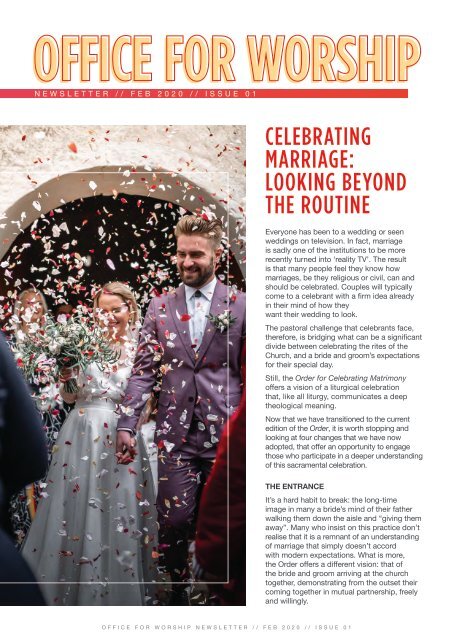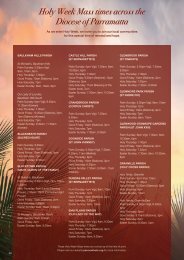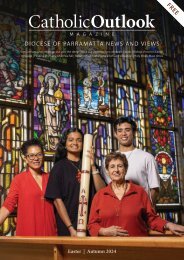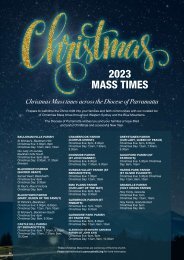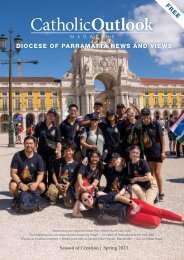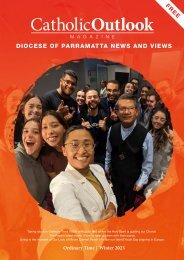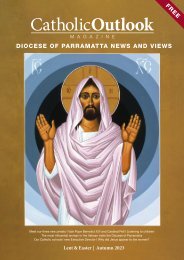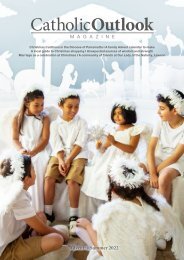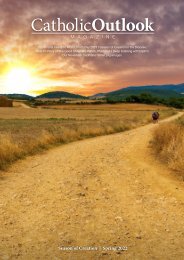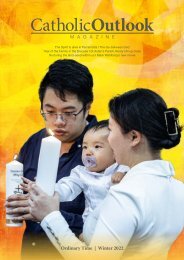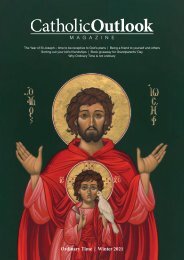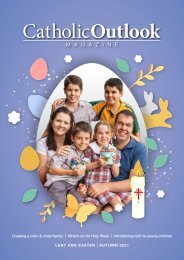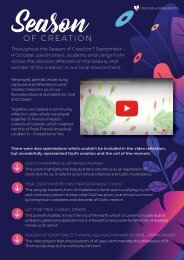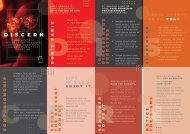Office for Worship Newsletter - Feb 2020
Create successful ePaper yourself
Turn your PDF publications into a flip-book with our unique Google optimized e-Paper software.
OFFICE FOR WORSHIP<br />
NEWSLETTER // FEB <strong>2020</strong> // ISSUE 01<br />
CELEBRATING<br />
MARRIAGE:<br />
LOOKING BEYOND<br />
THE ROUTINE<br />
Everyone has been to a wedding or seen<br />
weddings on television. In fact, marriage<br />
is sadly one of the institutions to be more<br />
recently turned into ‘reality TV’. The result<br />
is that many people feel they know how<br />
marriages, be they religious or civil, can and<br />
should be celebrated. Couples will typically<br />
come to a celebrant with a firm idea already<br />
in their mind of how they<br />
want their wedding to look.<br />
The pastoral challenge that celebrants face,<br />
there<strong>for</strong>e, is bridging what can be a significant<br />
divide between celebrating the rites of the<br />
Church, and a bride and groom’s expectations<br />
<strong>for</strong> their special day.<br />
Still, the Order <strong>for</strong> Celebrating Matrimony<br />
offers a vision of a liturgical celebration<br />
that, like all liturgy, communicates a deep<br />
theological meaning.<br />
Now that we have transitioned to the current<br />
edition of the Order, it is worth stopping and<br />
looking at four changes that we have now<br />
adopted, that offer an opportunity to engage<br />
those who participate in a deeper understanding<br />
of this sacramental celebration.<br />
THE ENTRANCE<br />
It’s a hard habit to break: the long-time<br />
image in many a bride’s mind of their father<br />
walking them down the aisle and “giving them<br />
away”. Many who insist on this practice don’t<br />
realise that it is a remnant of an understanding<br />
of marriage that simply doesn’t accord<br />
with modern expectations. What is more,<br />
the Order offers a different vision: that of<br />
the bride and groom arriving at the church<br />
together, demonstrating from the outset their<br />
coming together in mutual partnership, freely<br />
and willingly.<br />
OFFICE FOR WORSHIP NEWSLETTER // FEB <strong>2020</strong> // ISSUE 01
OFFICE FOR WORSHIP<br />
51 – 59 ALLAWAH STREET,<br />
BLACKTOWN NSW 2148<br />
02 8838 3457<br />
MARY-LOUISE.WALSH@PARRACATHOLIC.ORG
There remains a pastoral sensitivity<br />
in the provision of two options.<br />
In the first, the celebrant greets<br />
the bridal party at the door; a<br />
practice that mirrors that of other<br />
ritual celebrations. In the second,<br />
the celebrant meets the couple<br />
at the place where they will sit.<br />
Careful reading of the rubrics,<br />
however, reveals the implication<br />
that in both cases, the preference<br />
is that the couple come to either<br />
place together. While it may be<br />
hard to change the minds of some,<br />
encouraging a change to the<br />
archaic notion of “giving the bride<br />
away” is surely one that is worth<br />
the ef<strong>for</strong>t.<br />
THE GLORIA<br />
Those who read carefully over the<br />
rubrics of the Ritual Mass For the<br />
Celebration of Marriage in the latest<br />
edition of the Roman Missal would<br />
have noticed the rubric indicating<br />
the inclusion of the Gloria;<br />
something that was not previously<br />
called <strong>for</strong> in either the <strong>for</strong>mal<br />
missal or Rite of Marriage. We now<br />
also see this change reflected in<br />
the current Order of Celebrating<br />
Matrimony Within Mass.<br />
This inclusion sees the nuptial<br />
Mass af<strong>for</strong>ded a similar degree<br />
of solemnity to feast days. The<br />
challenge in many cases today,<br />
however, is choosing a suitable<br />
musical setting that can encourage<br />
an assembly not familiar with<br />
Sunday Mass to join inthis<br />
festive hymn.<br />
THE LITURGY OF THE WORD<br />
The introduction to the Order<br />
describes the Liturgy of the Word<br />
as one of the main elements of<br />
the celebration. The collection<br />
of readings provided was also<br />
expanded in this current edition.<br />
While this is often one of those<br />
times where reading roles are<br />
allocated to relatives or friends,<br />
we also owe it to the assembly<br />
<strong>for</strong> them to hear an outstanding<br />
proclamation of the Scriptures,<br />
and experience God speaking<br />
to them.<br />
Couples, there<strong>for</strong>e, should be<br />
encouraged to think carefully<br />
about who can fulfil this duty well.<br />
Alternatively, inviting Ministers<br />
of the Word from the parish<br />
community could help remind<br />
all involved that this sacramental<br />
celebration is one that belongs<br />
to the whole Church. Music<br />
ministers who serve at weddings<br />
will need to have in their settings<br />
of the various responsorial psalms<br />
repertoire and be well rehearsed.<br />
THE RECEPTION OF<br />
THE CONSENT<br />
The texts <strong>for</strong> the reception of<br />
consent were revised <strong>for</strong> this<br />
current edition, and again, there<br />
is an opportunity to engage the<br />
assembly that can easily be<br />
missed, or passed over with little<br />
fanfare. The celebrant invites to<br />
praise God <strong>for</strong> the commitment<br />
that has just been made by the<br />
couple. The rubric also suggests<br />
the possibility of singing an<br />
acclamation. Again, while it may<br />
be a challenge to successfully<br />
draw many wedding assemblies<br />
into a sung acclamation, being<br />
able to do so would be a fitting<br />
recognition of what the assembly<br />
has just witnessed.<br />
Celebrating the wedding ritual<br />
well does present its challenges.<br />
The opportunity <strong>for</strong> evangelisation<br />
and <strong>for</strong>mation that it presents,<br />
however, makes it important <strong>for</strong> us<br />
to try and realise the full potential<br />
of the ritual.<br />
SOURCING SCRIPTURE TEXTS<br />
FOR MARRIAGE CELEBRATIONS<br />
It is a common and good practice <strong>for</strong> the bride and groom to be invited to select the readings <strong>for</strong> their wedding.<br />
Often someone in the family will prepare a booklet <strong>for</strong> the assembly. With the ease of locating material on the<br />
internet, it is easy <strong>for</strong> people to source the texts of readings from biblical translations that are not approved <strong>for</strong><br />
use in Australia.<br />
Care needs to be taken that those preparing the readings make use of either the Jerusalem Bible or New Revised<br />
Standard Version translations, or, in the case of the psalms, the appropriate Grail translation. Digital versions of the<br />
correct translations are most easily sourced from online liturgy preparation resources such as Liturgia or Liturgy Help.<br />
OFFICE FOR WORSHIP NEWSLETTER // FEB <strong>2020</strong> // ISSUE 01<br />
2
liturgiaweddings.com.au<br />
A resource from Liturgy Brisbane<br />
THE WEDDING BY LITURGIA<br />
Following the release of its new online liturgy<br />
preparation resource, Liturgia, Liturgy Brisbane<br />
has now released The Wedding, an online resource<br />
using the Liturgia plat<strong>for</strong>m <strong>for</strong> preparing marriage<br />
celebrations. It is a comprehensive resource that<br />
provides ready access to the official liturgical<br />
texts and allows those preparing celebrations to<br />
compose an Order of Service and produce booklets.<br />
The Wedding by Liturgia also complements<br />
Liturgy Brisbane’s preparation resource, When<br />
We Marry, and the two resources can be purchased<br />
together as a package. Couples can purchase The<br />
Wedding themselves, or parishes can purchase<br />
copies from Liturgy Brisbane to give to couples<br />
as part of their preparation.<br />
ROBERT BARDEN IS THE CHAIRPERSON OF THE DIOCESAN LITURGICAL COMMISSION<br />
PREPARE YOUR WEDDING LITURGY<br />
Choose from the full range of prayers<br />
and readings <strong>for</strong> your Catholic wedding<br />
and prepare the liturgy from start to<br />
finish. No need to type in any texts!<br />
MUSIC & HYMNS<br />
View music suggestions <strong>for</strong> each<br />
part of the liturgy and insert your chosen<br />
hymns, with lyrics, into your liturgy plan.<br />
ACTIVATING YOUR SUBSCRIPTION<br />
Go to liturgiaweddings.com.au/App/Register<br />
and enter your unique subscription code.<br />
PRINT A BOOKLET<br />
Export your liturgy to Word or PDF and<br />
print a booklet, complete with images, so<br />
that everyone can follow the liturgy and<br />
join in the responses.<br />
CREATE A POWERPOINT<br />
Export all the texts of the liturgy<br />
to a PowerPoint presentation so that<br />
everyone can follow the texts of the<br />
liturgy on display screens.<br />
PERSONALISE THE RITUAL TEXTS<br />
Type in the names of bride and groom<br />
once, and the names appear correctly<br />
throughout all of the ritual texts.<br />
3<br />
OFFICE FOR WORSHIP NEWSLETTER // FEB <strong>2020</strong> // ISSUE 01
MUSIC FOR<br />
CATHOLIC WEDDINGS<br />
BY BERNARD KIRKPATRICK<br />
“Everybody loves a wedding!”….. so the saying goes.<br />
It’s a time of great celebration <strong>for</strong> the couple and their<br />
families, and of course, it’s a busy time of preparation<br />
in the lead up to the big day. There’s so much to<br />
organise, and there is usually a large investment of<br />
both time and money in arranging everything perfectly<br />
<strong>for</strong> what is the first day of a couple’s life long journey<br />
into marriage - booking the church, finding the right<br />
venue <strong>for</strong> the reception, choosing the right dresses<br />
<strong>for</strong> the bride and bridesmaids and suits <strong>for</strong> the groom<br />
and groomsmen. Then there’s the guest list, and the<br />
photographer and what cars are we having again? Oh,<br />
and did I mention the flower arrangements? And so<br />
the list goes on!<br />
It’s easy, there<strong>for</strong>e, to get swept up in organising<br />
these accessories, but what of the arrangements<br />
<strong>for</strong> the key part of the wedding celebration… i.e. the<br />
Liturgy? Sometimes it’s easy to think that the wedding<br />
celebration is a “private affair”, and that “it’s the<br />
bride’s day” as if there is no obligation to remember<br />
that the Sacrament of Matrimony is something which<br />
involves the whole church, or that the Rite of Marriage<br />
is given to us from the Church and her tradition.<br />
The Introduction of the new Order of Celebrating<br />
Matrimony1 states in para 12 “The preparation and<br />
celebration of Marriage, …belong, as regards pastoral<br />
and liturgical care, to the Bishop, to the pastor and his<br />
associates, and at least to some degree, to the entire<br />
ecclesial community (Cf/ JPII Apostolic Exhortation<br />
Familiaris consortio. No. 66 A.A.S. 74 (1982) 159-162.<br />
How does this impact on the Liturgy of Marriage,<br />
and, in particular, on the music arrangements <strong>for</strong><br />
such liturgy? Since it is an ecclesial event, then<br />
music arrangements should con<strong>for</strong>m to the principals<br />
required of music in our other liturgical celebrations.<br />
Para 30 of the New Order of Matrimony also requires<br />
that music “should express the faith of the Church”.<br />
Music which does not do this, or expresses secular<br />
themes or non-Christian concepts of love <strong>for</strong> example,<br />
should be discouraged. Choices such as “Mio babbino<br />
caro” of Puccini, or popular love songs such as<br />
“Perfect” by Ed Sheerin, are well loved songs, but<br />
they are not <strong>for</strong> sacred use.<br />
It can be a delicate pastoral issue to tell a bride and<br />
groom that their music choices are not suited to the<br />
liturgical celebration of their wedding. How does one<br />
do this in a way as not to give offence, or alienate<br />
those who may not see the need <strong>for</strong> “church songs” in<br />
church? [Note the simple terminology used here, when<br />
liaising with couples who may not understand word’s<br />
such as “liturgical”, “ritual”, “ecclesial”!]<br />
One simple way is to make sure to provide solutions<br />
to the dilemma and other options. For example,<br />
suggest secular songs might be more suitable<br />
played in the reception venue. Suggest that secular<br />
choices will sound more like what they expect, if<br />
played on CD or band at the reception venue. In any<br />
case, CDs and pre-recorded music in liturgy have<br />
no place. All liturgical worship is the offering of live<br />
liturgical ministers, integral to the rite and not merely<br />
ornamental fill-ins.<br />
Explain that Church musicians are experienced at<br />
playing church songs, and know the liturgy, so as they<br />
can tailor the music to suit the ceremony, avoiding<br />
awkward silences, or playing songs at the wrong<br />
moment! The many well trained liturgical musicians<br />
in our church also need to be supported <strong>for</strong> their<br />
contribution in our church communities, not replaced<br />
by “canned” music, which is a cheap option when<br />
compared to the amount of money invested in other<br />
aspects of the wedding day.<br />
Encourage bridal couples to engage such experienced<br />
church musicians, who are familiar with the liturgical<br />
music options and repertoire. Some couples are lured<br />
into engaging musicians who have no experience<br />
of Catholic church music, and who simply render<br />
Operatic arias, or pop songs more suited to cabaret or<br />
Broadway. Again, these musicians might have a place<br />
at the entertainment venue after the church ceremony.<br />
Invite couples to a music demonstration, with a<br />
liturgical musician/s, say a cantor and accompanist,<br />
who can demonstrate some suitable choices, such as<br />
the parts of the Nuptial Mass which would normally<br />
be sung at Sunday Mass – e.g. the Alleluia, Holy<br />
Holy, Acclamations, Lamb of God, and a Communion<br />
Hymn. There are plenty of choices, such as “Where<br />
there is charity and love”, and “Ubi caritas”, or “A new<br />
commandment I give unto you”, amongst many more.<br />
The Church musician usually has other options (often<br />
simply instrumental) which are also suited to the entry<br />
and recessional of the bridal party.<br />
OFFICE FOR WORSHIP NEWSLETTER // FEB <strong>2020</strong> // ISSUE 01<br />
4
OFFICE FOR WORSHIP NEWSLETTER // FEB <strong>2020</strong> // ISSUE 01
Choosing to engage a cantor, in<br />
addition to the accompanist, e.g.<br />
organist or keyboard player, will<br />
also result in greater success of<br />
members of the congregation<br />
participating musically with<br />
confidence, especially when parts<br />
of well-known Mass settings and<br />
hymns are selected. Without a<br />
cantor or lead singer, the likelihood<br />
of a congregation singing without<br />
the lead is significantly reduced!<br />
Even in Wedding Ceremonies<br />
(which have become more the<br />
norm than Nuptial Masses these<br />
days), allow <strong>for</strong> the inclusion of<br />
appropriate liturgical songs and<br />
acclamations throughout. For<br />
example, the revised “Order of<br />
Celebrating Matrimony, provides<br />
<strong>for</strong> music after the Reception<br />
of the Consent, and suggests a<br />
suitable acclamation song may<br />
be inserted – consider something<br />
short like the refrain of a hymn<br />
“Glory and Praise to our God” or<br />
in Lent “Glory and Praise to you,<br />
Lord Jesus Christ”. Also, after the<br />
Blessing and Giving of Rings, para<br />
68 provides <strong>for</strong> “a hymn or canticle<br />
of praise may be sung by the whole<br />
community” – so a longer choice<br />
of hymn might work here e.g. Ode<br />
to Joy, or “God is love, let heaven<br />
adore him”, “Brother, sister, let me<br />
serve you”, amongst others.<br />
Finally, <strong>for</strong> music ideas, don’t <strong>for</strong>got<br />
to consult the liturgical indexes<br />
of the catholic liturgical music<br />
resource books. Many hymnals<br />
have indexes which suggest<br />
hymns, songs and psalms which<br />
are suitable <strong>for</strong> weddings. Here I<br />
commend the Catholic <strong>Worship</strong><br />
Book II (published 2016) 2., the<br />
official Catholic music resource <strong>for</strong><br />
Australia, which has an excellent list<br />
of music suggestions <strong>for</strong> weddings.<br />
In my experience, guiding<br />
the wedding couple through the<br />
musical options, explaining why<br />
we use liturgical songs and music<br />
in worship, providing solutions and<br />
other options <strong>for</strong> the per<strong>for</strong>mance<br />
of music which are unsuited <strong>for</strong><br />
the Catholic wedding, is usually<br />
appreciated and accepted by<br />
them, and takes us back to where<br />
we started…. “Everybody loves<br />
a wedding!”<br />
BERNARD KIRKPATRICK IS THE DIRECTOR OF MUSIC AT ST. PATRICK’S CATHEDRAL, PARRAMATTA, AND A MEMBER OF THE<br />
DIOCESAN LITURGICAL COMMISSION.<br />
1. The Roman Ritual The Order of Celebrating Matrimony – English translation according to the Second Typical Edition- May 2015 (St. Pauls Publications) http://<br />
www.stpauls.com.au<br />
2. Catholic <strong>Worship</strong> Book II . 2016 by Morning Star Publishing https://morningstarpublishing.net.au/catholic-worship-book-ii/<br />
5<br />
OFFICE FOR WORSHIP NEWSLETTER // FEB <strong>2020</strong> // ISSUE 01
PARRACATHOLIC.ORG/OFFICE-FOR-WORSHIP


